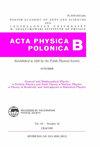质子-核碰撞中的胶子交换模型
IF 1.4
4区 物理与天体物理
Q3 PHYSICS, MULTIDISCIPLINARY
引用次数: 0
摘要
我们将我们最近制定的胶子交换模型(GEM)应用于涉及N>1质子-核子碰撞的质子-核反应中的重子产生。基于形成有效二夸克的概率对于所有允许的夸克对都相等的假设,我们提出了一种描述软色八隅体(胶子)交换过程的方案。后一种有效二夸克可以由二价、一价和一个海形成,也可以由两个海夸克形成。因此,我们计算了涉及价态二夸克、价海二夸克和海型二夸克的不同颜色构型的概率。这些概率似乎取决于交换胶子的数量,这导致重子停止的增加,作为核中质子-核子碰撞数量的函数。因此,核停止能力似乎是由作为N函数的新颜色构型的出现而不是由原始价二夸克的能量损失所决定的。我们的方法的优势在于其高预测能力,这使得它可以通过欧洲核子研究中心SPS关于质子和中子产生的新的精确数据进行验证。后面的验证,以及重子停止过程的N依赖性的一组预测,都包含在信中。本文章由计算机程序翻译,如有差异,请以英文原文为准。
The Gluon Exchange Model in Proton–Nucleus Collisions
We apply our recently formulated Gluon Exchange Model (GEM) to baryon production in proton-nucleus reactions involving N>1 proton-nucleon collisions. We propose a description scheme for the process of soft color octet (gluon) exchange, based on the assumption that probabilities to form an effective diquark are equal for all allowed pairs of quarks. The latter effective diquark can form either from two valence, one valence and one sea, or from two sea quarks. Consequently we calculate the probabilities for different color configurations involving diquarks of valence-valence, valence-sea and sea-sea type. These probabilities appear to depend on the number of exchanged gluons, which results in increasing baryon stopping as a function of the number of proton-nucleon collisions in the nucleus. As such, the nuclear stopping power appears to be governed by the emergence of new color configurations as a function of N rather than by the energy loss of the original valence diquark. The advantage of our approach lies in its high predictive power which makes it verifiable by the new, precise data on proton and neutron production from the CERN SPS. The latter verification, and a set of predictions for the N-dependence of the baryon stopping process, are included in the letter.
求助全文
通过发布文献求助,成功后即可免费获取论文全文。
去求助
来源期刊

Acta Physica Polonica B
物理-物理:综合
CiteScore
1.70
自引率
20.00%
发文量
30
审稿时长
3-8 weeks
期刊介绍:
Acta Physica Polonica B covers the following areas of physics:
-General and Mathematical Physics-
Particle Physics and Field Theory-
Nuclear Physics-
Theory of Relativity and Astrophysics-
Statistical Physics
 求助内容:
求助内容: 应助结果提醒方式:
应助结果提醒方式:


